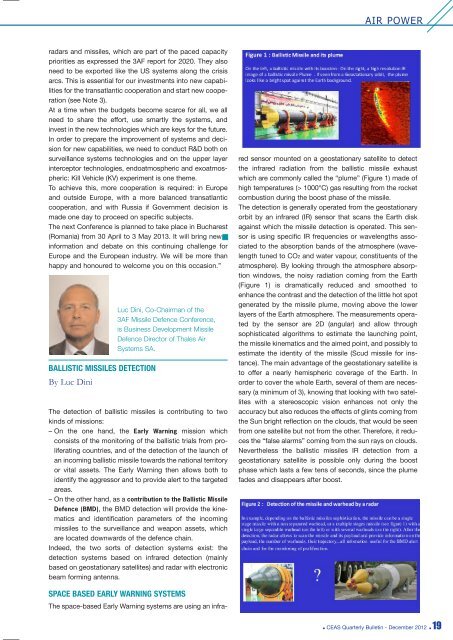Iam - CEAS. Council of European Aerospace Societies
Iam - CEAS. Council of European Aerospace Societies
Iam - CEAS. Council of European Aerospace Societies
You also want an ePaper? Increase the reach of your titles
YUMPU automatically turns print PDFs into web optimized ePapers that Google loves.
adars and missiles, which are part <strong>of</strong> the paced capacity<br />
priorities as expressed the 3AF report for 2020. They also<br />
need to be exported like the US systems along the crisis<br />
arcs. This is essential for our investments into new capabilities<br />
for the transatlantic cooperation and start new cooperation<br />
(see Note 3).<br />
At a time when the budgets become scarce for all, we all<br />
need to share the effort, use smartly the systems, and<br />
invest in the new technologies which are keys for the future.<br />
In order to prepare the improvement <strong>of</strong> systems and decision<br />
for new capabilities, we need to conduct R&D both on<br />
surveillance systems technologies and on the upper layer<br />
interceptor technologies, endoatmospheric and exoatmospheric:<br />
Kill Vehicle (KV) experiment is one theme.<br />
To achieve this, more cooperation is required: in Europe<br />
and outside Europe, with a more balanced transatlantic<br />
cooperation, and with Russia if Government decision is<br />
made one day to proceed on specific subjects.<br />
The next Conference is planned to take place in Bucharest<br />
(Romania) from 30 April to 3 May 2013. It will bring new<br />
information and debate on this continuing challenge for<br />
Europe and the <strong>European</strong> industry. We will be more than<br />
happy and honoured to welcome you on this occasion.”<br />
BALLISTIC MISSILES DETECTION<br />
By Luc Dini<br />
Luc Dini, Co-Chairman <strong>of</strong> the<br />
3AF Missile Defence Conference,<br />
is Business Development Missile<br />
Defence Director <strong>of</strong> Thales Air<br />
Systems SA.<br />
The detection <strong>of</strong> ballistic missiles is contributing to two<br />
kinds <strong>of</strong> missions:<br />
– On the one hand, the Early Warning mission which<br />
consists <strong>of</strong> the monitoring <strong>of</strong> the ballistic trials from proliferating<br />
countries, and <strong>of</strong> the detection <strong>of</strong> the launch <strong>of</strong><br />
an incoming ballistic missile towards the national territory<br />
or vital assets. The Early Warning then allows both to<br />
identify the aggressor and to provide alert to the targeted<br />
areas.<br />
– On the other hand, as a contribution to the Ballistic Missile<br />
Defence (BMD), the BMD detection will provide the kinematics<br />
and identification parameters <strong>of</strong> the incoming<br />
missiles to the surveillance and weapon assets, which<br />
are located downwards <strong>of</strong> the defence chain.<br />
Indeed, the two sorts <strong>of</strong> detection systems exist: the<br />
detection systems based on infrared detection (mainly<br />
based on geostationary satellites) and radar with electronic<br />
beam forming antenna.<br />
SPACE BASED EARLY WARNING SYSTEMS<br />
The space-based Early Warning systems are using an infra-<br />
AIR POWER<br />
red sensor mounted on a geostationary satellite to detect<br />
the infrared radiation from the ballistic missile exhaust<br />
which are commonly called the “plume” (Figure 1) made <strong>of</strong><br />
high temperatures (> 1000°C) gas resulting from the rocket<br />
combustion during the boost phase <strong>of</strong> the missile.<br />
The detection is generally operated from the geostationary<br />
orbit by an infrared (IR) sensor that scans the Earth disk<br />
against which the missile detection is operated. This sensor<br />
is using specific IR frequencies or wavelengths associated<br />
to the absorption bands <strong>of</strong> the atmosphere (wavelength<br />
tuned to CO2 and water vapour, constituents <strong>of</strong> the<br />
atmosphere). By looking through the atmosphere absorption<br />
windows, the noisy radiation coming from the Earth<br />
(Figure 1) is dramatically reduced and smoothed to<br />
enhance the contrast and the detection <strong>of</strong> the little hot spot<br />
generated by the missile plume, moving above the lower<br />
layers <strong>of</strong> the Earth atmosphere. The measurements operated<br />
by the sensor are 2D (angular) and allow through<br />
sophisticated algorithms to estimate the launching point,<br />
the missile kinematics and the aimed point, and possibly to<br />
estimate the identity <strong>of</strong> the missile (Scud missile for instance).<br />
The main advantage <strong>of</strong> the geostationary satellite is<br />
to <strong>of</strong>fer a nearly hemispheric coverage <strong>of</strong> the Earth. In<br />
order to cover the whole Earth, several <strong>of</strong> them are necessary<br />
(a minimum <strong>of</strong> 3), knowing that looking with two satellites<br />
with a stereoscopic vision enhances not only the<br />
accuracy but also reduces the effects <strong>of</strong> glints coming from<br />
the Sun bright reflection on the clouds, that would be seen<br />
from one satellite but not from the other. Therefore, it reduces<br />
the “false alarms” coming from the sun rays on clouds.<br />
Nevertheless the ballistic missiles IR detection from a<br />
geostationary satellite is possible only during the boost<br />
phase which lasts a few tens <strong>of</strong> seconds, since the plume<br />
fades and disappears after boost.<br />
• <strong>CEAS</strong> Quarterly Bulletin - December 2012 • 19



